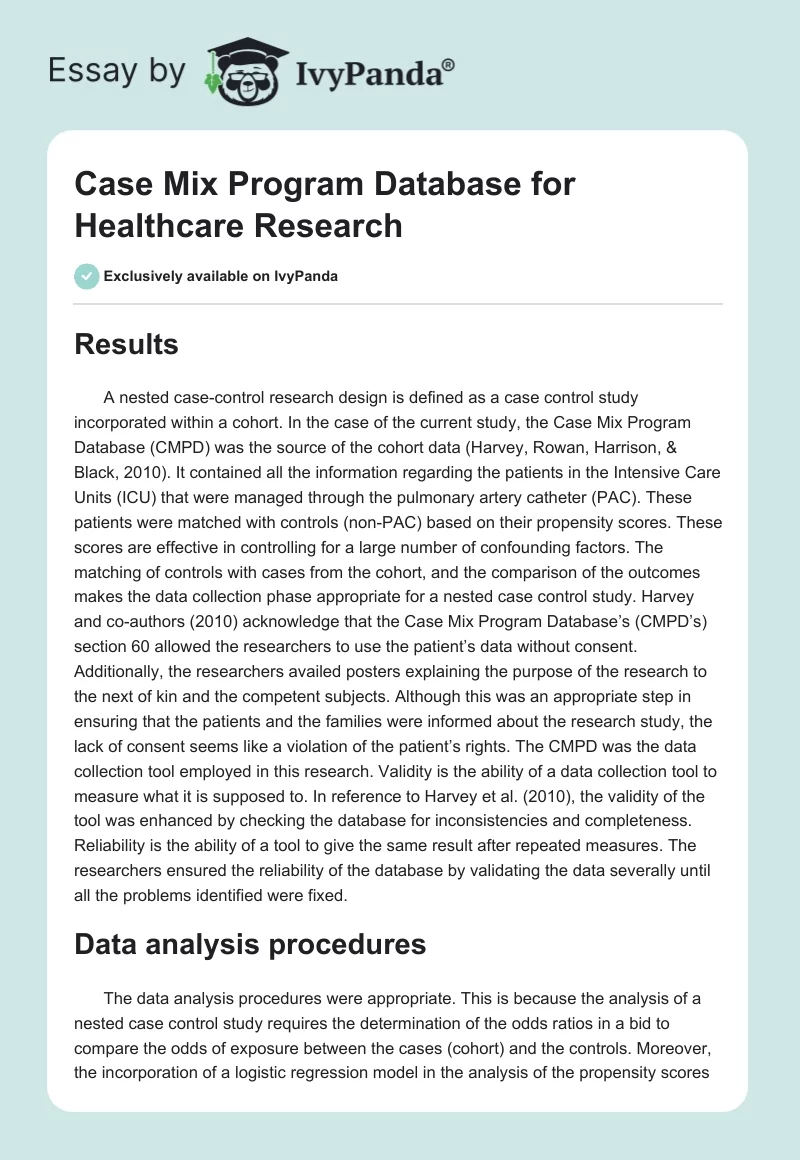Results
A nested case-control research design is defined as a case control study incorporated within a cohort. In the case of the current study, the Case Mix Program Database (CMPD) was the source of the cohort data (Harvey, Rowan, Harrison, & Black, 2010). It contained all the information regarding the patients in the Intensive Care Units (ICU) that were managed through the pulmonary artery catheter (PAC). These patients were matched with controls (non-PAC) based on their propensity scores. These scores are effective in controlling for a large number of confounding factors. The matching of controls with cases from the cohort, and the comparison of the outcomes makes the data collection phase appropriate for a nested case control study. Harvey and co-authors (2010) acknowledge that the Case Mix Program Database’s (CMPD’s) section 60 allowed the researchers to use the patient’s data without consent. Additionally, the researchers availed posters explaining the purpose of the research to the next of kin and the competent subjects. Although this was an appropriate step in ensuring that the patients and the families were informed about the research study, the lack of consent seems like a violation of the patient’s rights. The CMPD was the data collection tool employed in this research. Validity is the ability of a data collection tool to measure what it is supposed to. In reference to Harvey et al. (2010), the validity of the tool was enhanced by checking the database for inconsistencies and completeness. Reliability is the ability of a tool to give the same result after repeated measures. The researchers ensured the reliability of the database by validating the data severally until all the problems identified were fixed.
Data analysis procedures
The data analysis procedures were appropriate. This is because the analysis of a nested case control study requires the determination of the odds ratios in a bid to compare the odds of exposure between the cases (cohort) and the controls. Moreover, the incorporation of a logistic regression model in the analysis of the propensity scores controlled for confounding and provided data on the adjusted odds ratio. According to Harvey et al. (2010), the ICNRARC risk prediction model allowed the calculation of the predicted risk of death in the two groups. Although the article does not outline the research questions, two main questions can be deduced:
- Does the incorporation of PAC reduce the mortality of critically ill patients?
- Does employing NRS’s provide an alternative method to RCT’s in evaluating healthcare interventions?
Based on these questions, the data analysis procedures were suitable for providing the answers required for the study. The risk-prediction model analysis provided information on the predicted mortality risks for using PAC (Harvey et al., 2010). In addition, the logistic regression analysis enabled the computation of the propensity scores for the cases and controls, and provided evidence in support of the use of NRS’s in healthcare interventions. There are two main differences between qualitative and quantitative data. First, quantitative data is expressed in the form of numbers, which is not possible in the case of qualitative data. Furthermore, quantitative data allows for statistical manipulation using a variety of tests. Second, qualitative data gives an in-depth analysis of the point of view of the research subjects, which is not the case for quantitative data.
Conclusion
Harvey et al. (2010) ensured that the case and the control group had similar baseline characteristics. The findings indicate that more patients (60%) with PAC died compared to the controls (54%). However, further analysis revealed that the severity of the illness was an effect modifier in the relationship between PAC use and death. Based on the mortality risk-prediction model, the PAC group had an increased odd of dying. The findings also show that the PAC group (alive or dead) had longer stays in the ICU and in the hospital compared to the non-PAC group. Generally, these findings revealed that the patient outcomes were worse in the PAC group (Harvey et al., 2010). Lastly, this research suggested that the incorporation of rigorous NRS’s could be used as an alternative to RCT’s in hospital based intervention studies.
Harvey et al. (2010) identified three major strengths of the research, which promoted its scientific merit. First, the CMPD was a high-quality clinical database. It also covered a variety of health facilities and hence promoted the representativeness of the study findings. Second, the findings of the current research were more generalizable (external validity) compared to the findings from other NRS’s carried out in the past. This is because it incorporated ICU’s located in both teaching and non-teaching hospitals. Third, the validity and predictive power of the model was brilliant as it was well defined and had no exclusion criteria. The major limitation of employing the NRS’s was the inability to determine whether the analysis had controlled for all the potential confounders (Harvey et al., 2010). The presence of confounders is likely to skew the true associations of the study and lead to flawed conclusions. Lastly, the findings do not support the hypotheses of the study. Contrary to the first hypothesis, the results reveal that NRS’s can be used as an alternative method of evaluating interventions in healthcare. As aforementioned, the analysis also showed that the mortality rate was higher in the PAC group, which conflicted with the second hypothesis.
Reference
Harvey, S., Rowan, K., Harrison, D., & Black, N. (2010). Using clinical databases to evaluate healthcare interventions. International Journal of Technology Assessment in Health Care, 26(1), 86–94.


